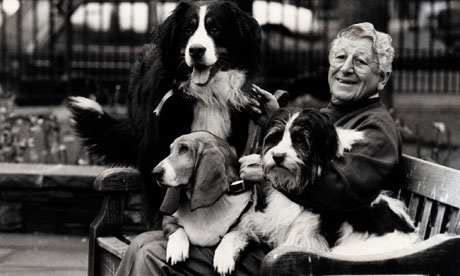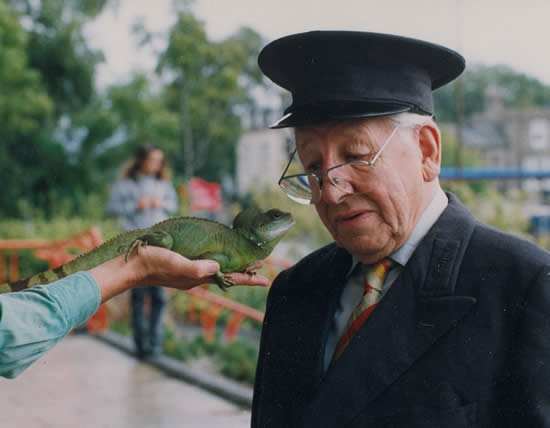





Hi there and welcome to Ado's Blog. I am obsessed with nostalgia, especially 1960s & 1970s nostalgia and I enjoy nothing more than reflecting on days and times that have sadly long since gone! So join me, as I take a nostalgic gander down Memory Lane and celebrate all things past and occasional present, both good and bad! (All images used that are copyrighted are copyrighted to their respective publishers and are only used here for review purposes.)






Johnny Morris had been a voices man on children's radio and was well-known as television storyteller the Hot Chestnut Man (seen in Playbox, BBC, 1955-64) when approached by Desmond Hawkins, then setting up the Natural History Unit at BBC Bristol and looking to create a programme for children.
The first programme aired 13 April 1962, featuring zoo vet Gerald Durrell and reporter Tony Soper out in the field with a film from Pembrokeshire. Morris meanwhile had a run in with a woolly monkey called Darkie - it climbed over Morris' head as the presenter tried to do his piece to camera but Johnny took it all in good humour, setting the tone for the next twenty-odd years.


The programme tried to keep up with modern techniques, for instance quickly and successfully aping the special effects-heavy approach of Bellamy's Backyard Safari (BBC, 1981) in a special programme Animal Magic Goes Down To Earth (tx 8/9/81). Johnny and co-host Terry Nutkinswere shrunk to a few inches high to explore a farmyard now full of dangerous giant creatures.
The whimsical eccentricity for which Animal Magic was most loved led to its demise when in 1983 new BBC bosses judged it too 'unscientific'. Tony Soper pioneered more scientific approaches in Wildtrack (BBC, 1978-85) and Terry Nutkins headed Animal Magic's award-winning successor The Really Wild Show from 1986.


Morris was discovered telling stories in a pub by the then BBC Home Service West Regional producer Desmond Hawkins. Morris made his radio debut in 1946, and featured in a number of Regional series throughout the 1950s often employed on light and entertainment programs as a storyteller, such as in Pass the Salt, or as a commentator on local events.
A natural mimic and impersonator, Morris first appeared on television as The Hot Chestnut Man, a short slot in which he was shown sitting roasting the chestnuts, he would tell a humorous yarn in a West Country Accent, often ending with a Moral.
In 1960 he narrated the imported, Canadian-produced Tales of the Riverbank series of stories about Hammy the Hamster, Roderick the Rat, GP the Guinea Pig, and their assorted animal friends along a riverbank. The show used slowed-down footage of real animals filmed doing humanised things such as driving a car or boat, and living in houses. In the 1960s Morris also narrated books 1 - 8 of The Railway Stories, recordings of the railway series books by the Rev. W. Awdry.
Morris's ability to create a world which children could relate to through his mimicry led to his best-known role, that of the presenter, narrator and 'Zoo Keeper' for Animal Magic. For more than 400 editions, from 1962 until 1983, and with inserts shot at Bristol Zoo Gardens, Morris would carry out a comic dialogue with the animals, whom he also voiced. His regular companion on the show was Dotty the Ring Tailed Lemur. When the idea of imposing human qualities and voices upon animals fell out of favour the series was discontinued.
Morris carried over his comedic commentary technique into other programmes, such as Follow the Rhine, a BBC2 travelogue which included a witty Morris commentary featuring his companion Tubby Foster – actually his producer Brian Patten. Follow the Rhine was based on Morris' earlier BBC Radio 4 series Johnny's Jaunts. These series chronicled not only the Rhine journey but other worldwide journeys and were broadcast between 1957 and 1976. Included in this series were tales based upon his visits to such places as Austria (a skiing misadventure!), Spain, Hong Kong, Japan, USA, Singapore, Malaysia, Thailand, South America, South Sea Islands, France; and even a cruise on the River Thames.

Morris was also Vice President of the Bluebell Railway in Sussex from its early days in the 1960s until the late 1980s, attending several anniversaries and landmark events over the first few decades of the railway's existence. He also made two promotional LP's for the Railway in the 1970s.
In the 1970s, Morris read children's bedtime stories for the Post Office to be heard via the telephone. Children could dial 150 and hear a different story over the telephone each week. He was also a presenter on BBC School Radio's Singing Together and wrote and read stories on BBC School Radio's A Service for Schools which was later renamed Together.
In a nod to his role with Animal Magic, Morris also added his voice to the award-winning Creature Comforts series of electricity advertisements, created by Aardman Animations. These advertisements featured animated claymation animals speaking about their life and conditions in a way comparable to the dialogues that Morris has created in the earlier television show.
Although latterly criticised in the 1990s for his anthropomorphic technique of introducing television viewers to animals, Morris was active in environmentalism in his eighties demonstrated against the building of the Newbury Bypass near his home. In June 2004, Morris and Bill Oddie were jointly profiled in the first of a three part BBC Two series, The Way We Went Wild, about television wildlife presenters.
Morris was awarded the OBE in 1984. His autobiography, There's Lovely, was first published in 1989.


It was the 32-year-old's second successful attempt to break into Buckingham Palace. On his first attempt, he scaled a drainpipe, briefly startling a housemaid who called security, who subsequently decided not to act. Fagan entered through an unlocked window on the roof and spent the next half hour eating cheddar cheese and crackers and wandering around. He tripped several alarms, but they were faulty. He viewed the royal portraits and rested on the throne for a while. He then entered the postroom, where the pregnant Diana, Princess of Wales had hidden presents for her first son, William. He drank half a bottle of California white wine before becoming tired and leaving.
On the second attempt, an alarm sensor detected him. A worker in the Palace thought the alarm to be false, and silenced the alarm. En route to see the Queen, he broke a glass ashtray, lacerating his hand.
Her Magesty woke when he disturbed a curtain, after which he sat on the edge of her bed talking to her for about ten minutes. The Queen phoned twice for police but none came. He then asked for some cigarettes, which were brought by a maid. When the maid did not return to base for some time Footman Paul Whybrew appeared. The incident happened as the armed police officer outside the royal bedroom came off duty before his replacement arrived. He had been out walking the Queen's dogs.









